Screens Bring Museums Closer To The Visitor
It is really great to see how the use of digital signage enhances visitors experience in museums and at touristic sites.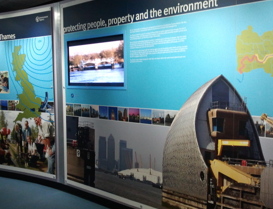 Last weekend the Thames Barrier was opened and I went to see it for the first time. It’s a truly amazing piece of engineering. Besides it, by the café, there was a small visitor’s centre where kind guides were talking people through how it works and answered any questions. Although small the centre had several screens to show material that further expand the knowledge one had about the Barrier and gave it a better context.
Last weekend the Thames Barrier was opened and I went to see it for the first time. It’s a truly amazing piece of engineering. Besides it, by the café, there was a small visitor’s centre where kind guides were talking people through how it works and answered any questions. Although small the centre had several screens to show material that further expand the knowledge one had about the Barrier and gave it a better context.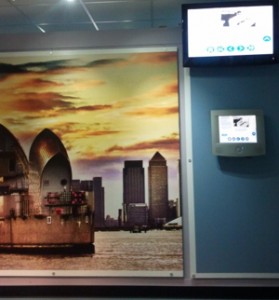
Also in the south east, in Greenwich, the National Maritime Museum has updated one of its galleries using projection over not flat surfaces, screens and soundscapes. Located at the Sammy Ofer Wing, the ‘Voyagers Gallery’ is a permanent exhibition dedicated to helping visitors gain a richer understanding of Britain’s maritime heritage.
Electrosonic was selected by the museum to supply, install, commission and provide warranty of the audio-visual hardware. The gallery £36.5m project, was designed by Real Studios, with audio-visual creative direction by the Light Surgeons.
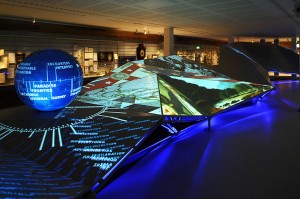
The new wing is the largest development in the museum’s history and is the first step of a five year plan to revitalise and refresh its galleries and exhibitions. The Voyagers Gallery brings together hundreds of objects, innovative audio-visual presentations and newly-commissioned videos all in one space. The novel projection system will help the Museum to make maritime subjects relevant to visitors on a personal level, telling stories of adventures and discovery in a unique and imaginative way.
“The Sammy Ofer Wing creates a spectacular contemporary environment in which more people can appreciate the wonders of our world-class collections and their stories of human endeavour and discovery.” commented Kevin Fewster, National Maritime Museum Director.
The first thing visitors see upon entering Voyagers is a 25 metre dynamic wave-like structure, featuring bespoke video projections and a specially-designed sound-scape. Seven Panasonic projectors are used to display intensely coloured patterns of images and words which appear to wash over the wave’s multi-faceted surface, simulating the rise and fall of the ocean.
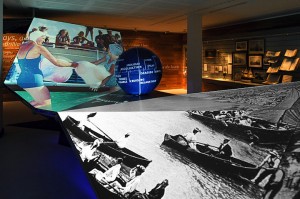
At the far end of the structure a Puffersphere spherical projector appears to float on top of the Wave; a Christie projector placed inside its centre displays individual words and images onto the giant globe taking visitors on a visual journey into maritime history.
The Wave and Puffersphere are animated in real time using ‘openFrameworks.’
Behind the Wave is a 30 metre long object wall, housing over two hundred artefacts; the Museum has taken the rather unusual approach of ordering them by emotion – anticipation, love, sadness, aggression, pride and joy.
The final element of Voyagers is a series of video portraits, Talking Heads. These take the form of recorded first person accounts from ordinary and extraordinary people from all over the world – coastguards, émigrés, naval officers, schoolchildren – each with their own story.
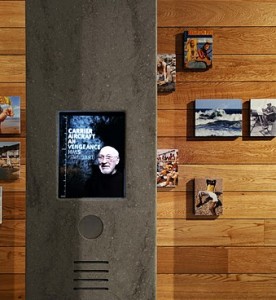
A series of columns are placed towards the exit of the gallery through which the visitors pass to leave. Eight small video monitors inset in these columns show short films of people answering questions such as: “What does the sea mean to you?”, “What is your maritime story?”, “What are your memories of the sea?” Specially recorded at the museum earlier this year they provide a sometimes humorous, sometimes thought-provoking and even provocative insight into how Britons, as inhabitants of an island nation, still maintain powerful and meaningful relationships with the sea.

October 13th, 2011 at 15:57 @706
A great piece that showcases digital signage application at its very best. Elevating an experience far beyond what would have been possible without it.